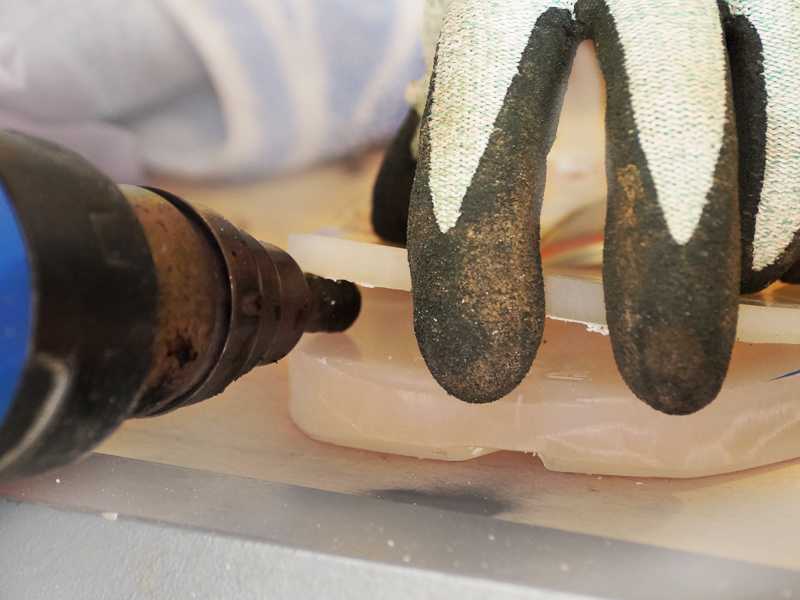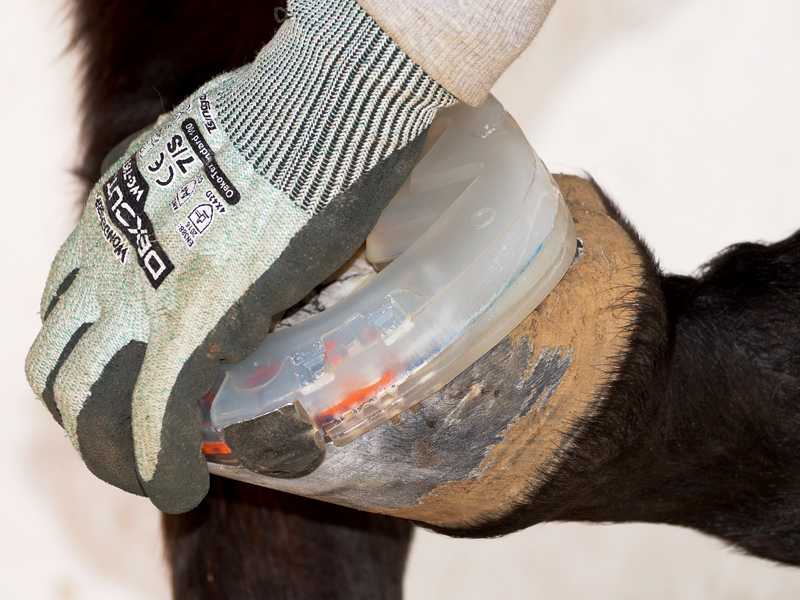Synthetic Wedges for Adjusting Your Horse's Hoof Angle
go to the online shopAdjusting the Hoof Angle with a Plastic Wedge Combined with a Hybrid Horseshoe
In the context of hoof care, as a farrier, you are constantly faced with various challenges in your
daily work, especially when it's necessary to alter the hoof angle. Typically, a wedge pad
is used for this purpose, allowing you to achieve an elevation of the heels.
The reasons for needing to elevate the heels with wedge pads can be diverse. Especially in
corrective shoeing, which includes the use of wedges, there are no universal statements. A wedge
might help one horse with underrun heels, but it could harm another horse. The same goes for
conditions like navicular syndrome – what might be beneficial for one horse could worsen the
condition for another.
This is why we cannot provide general guidance on the applications of wedge pads. We recommend that the decision to use a wedge, the angle at which the elevation should occur, and the duration of usage should always be discussed with the on-site veterinarian.
The purpose of wedge pads is to elevate the heels and steepen the hoof angle, effectively putting the hoof more on its tip. When utilizing wedges to elevate the heels, it's common to also adjust the toe rocker to optimize breakover. This is also achievable with a plastic shoe. Depending on the specific reason for needing a wedge, using a shock-absorbing plastic shoe, with or without a stabilizing metal core, could be beneficial. Especially when a horse is in pain, this shock absorption can be perceived as comfortable by the horse.
A plastic wedge induces a 2.5 degree change in the hoof angle. If necessary, it's also possible to insert two wedge pads into the shoe, resulting in a 5.0 degree alteration. For these applications, you can purchase our plastic wedge.
Please note that our products do not diagnose or cure any diseases. Any application in the therapeutic or orthopedic domain lies within the discretion of the on-site farrier and should always be coordinated with the treating veterinarian, particularly when dealing with corrective shoeing involving wedges.
Elevation of the Heels with Wedge Pads in Horseshoeing - Photos

Begin by performing the barefoot trimming and adjusting the shoe to the hoof as usual. Afterward, place the wedge pad in the prepared shoe.

Adjust the wedge pad to the shoe, for example using a grinder. Be sure to avoid inhaling any grinding dust.

It is possible (but not mandatory) to fix the wedge pad in place using spot welding. To do this, you can use your heat gun with a reduction nozzle.

To achieve a change of the hoof angle of 5.0 degrees, combine two plastic wedge pads together.

Ensuring the precise fit of the horseshoe is paramount. Confirm the accuracy of your wedge pad shoe before applying it to the horse.

You can attach the wedge shoe for heel elevation using glue, nails, or even apply it half-glued and half-nailed.
Application and Safety Instructions - Heel Elevation with Wedge Pads - Video
Whether during hoof care or later in the pasture or while riding, there are certain Safety Instructions and risks that we need to bring to your attention. Our safety guidelines are intended not only for farriers but also for horse owners and riders. Please observe these guidelines to prevent injuries to both humans and horses.
If you have further questions regarding the application of corrective shoeing with wedge pads, we are here to assist you. However, please be aware that it's not possible for us to provide remote diagnosis, and the general information about our products, especially in regards to orthopedic or therapeutic applications, cannot be directly applied to every individual horse. Since wedges are typically used as therapeutic aids, they should only be applied by hoof professionals in collaboration with the local veterinarian.
Shoeing with Wedge Pads
Alteration of the hoof angle using wedge pads as part of orthopedic or therapeutic shoeing requires the necessary expertise.
The appropriate barefoot trimming and adjustment of the shoe and the wedge pad are extremely important in corrective shoeing. We would like to recommend our general shoeing guide to you for further information on this.
When using a wedge, perform the barefoot trimming as usual and adjust the shoe to the individual hoof shape. Then, place the wedge in the shoe and adjust it to the shoe before nailing or gluing it to the hoof. You can also spot-fix the wedge using a heat gun.
A single wedge pad induces a 2.5 degree angle change; by using two wedge pads, you can achieve a 5 degree alteration.
Creatively Using Wedges
In the following video, we demonstrate the possibilities of working with a wedge in a special case.
Sandy Frank shoes her horse with a clipped composite horseshoe, using a wedge to alter the hoof angle by 2.5 degrees. What makes this case special is that it is half-nailed and half-glued. It is evident that creativity has almost no limits, allowing the farrier to tailor their approach to the horse's specific needs on-site.
Adjusting Breakover
Since it often makes sense to incorporate a toe rocker when using wedge pads, we would like to briefly discuss the modification options of our plastic horseshoes.
- Rocked Toe Shoe - Adjust by Grinding
With a plastic shoe, you can achieve the toe rocker in various ways. If you have an angle grinder or a belt sander at your disposal, you can modify the horseshoe accordingly. - Rolled Toe Shoe - Adjust by Bending:
A less common method is to bend the toe rocker. To do this, secure the plastic shoe on the anvil edge or in a vice and reshape it using a hammer. -
At this point, we would like to offer you a small tip:
If you wish to place the horseshoe further backwards to achieve an earlier breakover point, our straight toe shoes could be a possible alternative for you. The STS models come in a round shape with a slightly straightened toe. The quarter clips of these models are positioned further backwards compared to our other shoes. Furthermore, all STS models already have a certain toe rocker, potentially saving you the need for adding a rolled or rockered toe later. Of course, you can also purchase wedge pads that are compatible with the STS models.


Application of the Wedge Pad for Clipped and Unclipped Hybrid Horseshoes
The easiest application of the plastic wedges is in combination with a clipped horseshoe (excluding open-toe models). The wedges are available in all existing shoe sizes, both in round and oval shapes as well as in the STS form; this makes the application very straightforward.
-
Wedges in Combination with a Clipped Horseshoe:
When using the wedge pads with a clipped horseshoe, the wedge is precisely fitted for the nailing slots and knob arrays of the shoe. Therefore, the wedge pad does not need to be manually adjusted to match the knob arrays or nailing slots of the shoe before use. As a result, it is recommended in most cases to use a clipped horseshoe. - Wedges in Combination with an Unclipped Horseshoe:
If you intend to combine the wedge pads with an unclipped shoe, the process will depend on whether it's an already modified model or not.- In the case of the already revised sizes, the positions of the nailing slots in the unclipped shoe align precisely with those of the wedge pad. When using a wedge pad with these shoes, you only need to sand down part of the knob arrays to match them to the wedge pad.
- Using the wedges with the older (not yet revised) unclipped models is feasible in theory, but it often involves a significant amount of effort.


Product Features
| Model | Wedge |
|---|---|
| Brand | Duplo |
| Additional Title | plastic horseshoe wedge, ring-shaped full wedge pad, wedge pad, 2.5 degree wedge, horseshoe wedge, plastic wedge pad |
| Article Number | 080, 081, H80, H81, 1010 |
| Function | wedge shoe, corrective shoeing, provides a heel lift, changing the hoof angle, elevating the heels, raise the heels by 2.5 degrees, wedging heels, wedge the heel up, wedged hoof, adjust breakover |
| Therapy Shoe / Rehab Shoe | Wedges provide a heel lift and are used to change the hoof angle. We expressly point out that our products do not diagnose or cure any diseases and advise for any use with a therapeutic or orthopedic background to work closely with the hoof specialist or veterinarian on site. |
| Horse Breeds | among others, Warmblood, Thoroughbred, Draft Horse, Quarter Horse, Paint Horse, Haflinger, Icelandic, Arabian, Friesian, Andalusian, Hanoverian |
| Shoeing | can be applied with nails, glue, or casting hooks |
| Shoeing Instruction | can be found under FAQ → Instructions |
| Security Advices | can be found under FAQ → Safety Information |
| Made in | Germany |
| Available Sizes | front pattern (ususally round) / hind pattern (usually oval) / STS (special front pattern shape with a slightly straightened toe area) |
| Sizes Round - Front Pattern | 102mm, 106mm, 110mm, 114mm, 118mm, 122mm, 126mm, 130mm, 134mm, 138mm, 142mm, 146mm, 150mm, 154mm, 158mm, 162mm, 166mm, 170mm, 174mm, 178mm, 182mm, 190mm, 198mm |
| Sizes Oval - Hind Pattern | 98mm, 102mm, 106mm, 110mm, 114mm, 118mm, 122mm, 126mm, 130mm, 134mm, 138mm, 142mm, 146mm, 150mm, 154mm, 158mm, 162mm, 166mm, 170mm, 174mm, 178mm, 182mm, 190mm, 198mm |
| Sizes STS | 102mm, 106mm, 110mm, 114mm, 118mm, 122mm, 126mm, 130mm, 134mm, 138mm, 142mm, 146mm, 150mm, 154mm |
| Sizing | in 4mm steps; in 8mm steps from size 182mm on |
| Sizing | based on the horseshoe used |
| Season | all year round |
| Weight | depending on the size, from 30g up to 210g |
| Length | depending on te size - for details please visit FAQ → Sizes and Shapes |
| Width | the respective size in mm |
| Packaging Unit | in pieces |
| Shipment | within Canada - for worldwide shipments please contact the Duplo Team in Germany |
Special Features of our Plastic Wedges
Ring Shape
Our wedge pads are designed in a ring shape, covering the entire contact area of the shoe. This design enhances the stability of the wedge on the horse's hoof, reducing the likelihood of slipping as it's securely anchored across a larger surface area. This applies to both glued-on and nailed-on wedge shoe applications.

Anatomical Sole Relief
The shape of the wedge is based on the anatomy of the hoof. A molded bevel provides
for perfect fit around the sensitive sole and avoids needless pressure.
When
using a clipped horseshoe, you only need to adjust the wedge pad to the hoof
shape before using it.

Manufactured from Recycled Material
The excess sprues generated during our production process are recycled through a
proper procedure to produce plastic regrind. Using this recycled material, we create
our wedges (among other products).
We are pleased to make a small contribution towards
better resource management through this initiative.



